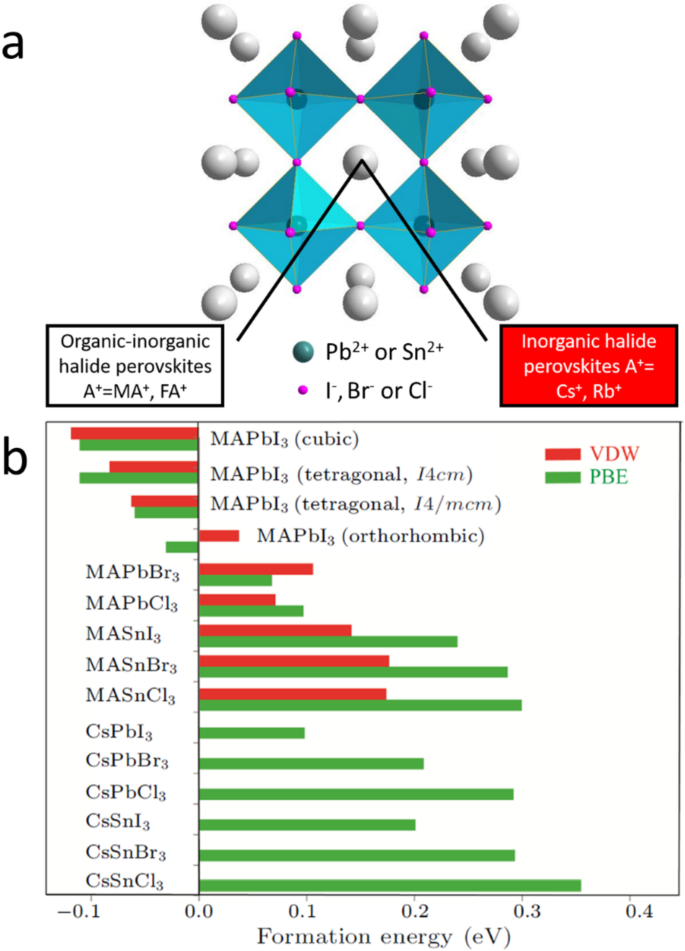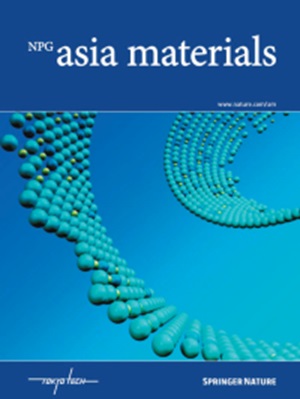用于高效光电设备的碘化铯铅包晶石的相稳定化
IF 8.3
2区 材料科学
Q1 MATERIALS SCIENCE, MULTIDISCIPLINARY
引用次数: 0
摘要
全无机卤化铅包晶石(LHPs)及其在光电器件中的应用已得到广泛探索,因为它们比有机-无机混合包晶石具有更高的热稳定性。然而,由于临界结构耐受因子的影响,一些无机 LHP 的活性包晶石相在室温下是易陨的。例如,黑相 CsPbI3 在常温下很容易转变回非过氧化物黄相。人们一直在关注如何提高无机 LHP 的相稳定性,尤其是那些具有高太阳能电池效率的 LHP。在此,我们讨论了 CsPbI3 相稳定性的起源以及用于稳定立方(α)相的策略。我们还评估了在接近室温时相对稳定的 CsPbI3 黑色 β/γ 相。此外,我们还确定了相稳定与缺陷钝化之间的关系,并回顾了基于黑相 CsPbI3 的太阳能电池效率的增长趋势。最后,我们展望了与追求最佳器件效率和绿色能源相关的未来研究。本文章由计算机程序翻译,如有差异,请以英文原文为准。


Phase stabilization of cesium lead iodide perovskites for use in efficient optoelectronic devices
All-inorganic lead halide perovskites (LHPs) and their use in optoelectronic devices have been widely explored because they are more thermally stable than their hybrid organic‒inorganic counterparts. However, the active perovskite phases of some inorganic LHPs are metastable at room temperature due to the critical structural tolerance factor. For example, black phase CsPbI3 is easily transformed back to the nonperovskite yellow phase at ambient temperature. Much attention has been paid to improving the phase stabilities of inorganic LHPs, especially those with high solar cell efficiencies. Herein, we discussed the origin of phase stability for CsPbI3 and the strategies used to stabilize the cubic (α) phase. We also assessed the CsPbI3 black β/γ phases that are relatively stable at nearly room temperature. Furthermore, we determined the relationship between phase stabilization and defect passivation and reviewed the growing trend in solar cell efficiency based on black phase CsPbI3. Finally, we provide perspectives for future research related to the quest for optimum device efficiency and green energy. Black phase CsPbI3 easily transforms into the non-perovskite yellow phase, while losing the outstanding optoelectronic properties. In this review, the origin of the phase stability in CsPbI3 and strategies to stabilize the black phases exhibiting the α-phase or the relatively easily stabilized β/γ-phases are extensively discussed. Furthermore, a profound analysis of the CsPbI3 stabilization progress and the evolution of the performance efficiency records of black phase CsPbI3 is provided. Lastly, a prospective on future research on CsPbI3 solar cells pinpoints the current challenges and directs future research approaches toward more efficient and stable devices.
求助全文
通过发布文献求助,成功后即可免费获取论文全文。
去求助
来源期刊

Npg Asia Materials
MATERIALS SCIENCE, MULTIDISCIPLINARY-
CiteScore
15.40
自引率
1.00%
发文量
87
审稿时长
2 months
期刊介绍:
NPG Asia Materials is an open access, international journal that publishes peer-reviewed review and primary research articles in the field of materials sciences. The journal has a global outlook and reach, with a base in the Asia-Pacific region to reflect the significant and growing output of materials research from this area. The target audience for NPG Asia Materials is scientists and researchers involved in materials research, covering a wide range of disciplines including physical and chemical sciences, biotechnology, and nanotechnology. The journal particularly welcomes high-quality articles from rapidly advancing areas that bridge the gap between materials science and engineering, as well as the classical disciplines of physics, chemistry, and biology. NPG Asia Materials is abstracted/indexed in Journal Citation Reports/Science Edition Web of Knowledge, Google Scholar, Chemical Abstract Services, Scopus, Ulrichsweb (ProQuest), and Scirus.
 求助内容:
求助内容: 应助结果提醒方式:
应助结果提醒方式:


